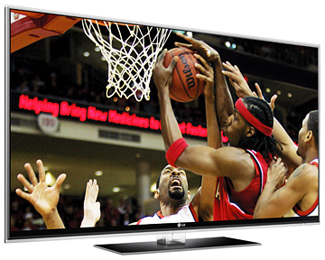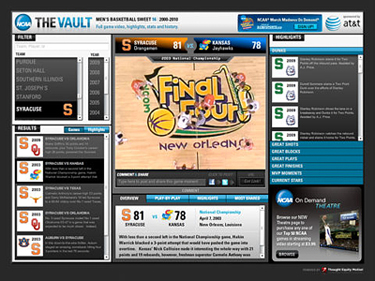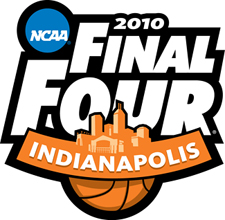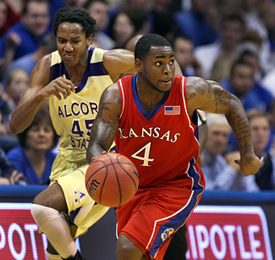3D Madness

INDIANAPOLIS
The NCAA Basketball Tournament is getting its first taste of the latest in television technology when the Final Four is broadcast in 3D.
LG Electronics USA and Cinedigm Digital Cinema Corp. are co-sponsoring this particular madness, produced by CBS Sports for up to 100 digital cinemas nationwide. Fans lucky enough to get tickets to the live events at Lucas Oil Stadium will also see the action in 3D on LG LCD HDTVs at locations around the venue, as will the thousands visiting the NCAA’s “Bracket Town refreshed by Coca-Cola Zero.” Bracket Town, a fan zone co-sponsored by CBS and other corporate entities, will host games, instruction and other activities at the Indianapolis Convention Center, April 1-5.
PRODUCING 3D
Delivering the competition in 3D was described as “a bit of a challenge” by Ken Aagaard, CBS Sports executive vice president of operations and engineering.
“We have to be able to figure out how to put together a comprehensive production plan that allows us to keep the basketball fans happy and give movie theatre goers a 3D experience,” he said. “We’re making sure that you’re seeing the depth, but you’re not seeing that huge ‘in-your-face’ kind of 3D.”

The NCAA Vault is a digitized archive of March Madness games. 3D camera rigs will be provided by Burbank, Calif.-based Pace digital camera systems, owned by 3D pioneer Vince Pace, who supplied rigs and expertise for James Cameron’s “Avatar” and the NBA 3D Finals in 3D. NEP, which also worked on 3D productions, will provide its Supershooter 9 mobile unit.
“It’s a totally different approach to doing television,” said NEP’s chief technology officer George Hoover of CBS Sports’ 3D initiative. “The camera positions are different, the shooting patterns are different, shot composition’s different.”
The biggest change, said Hoover, is having cameras lower and closer to the court for the 3D telecast.
“There’s very little depth of field when you get up high and far away,” said Hoover. “To provide 3D images that are interesting, the cameras need to be positioned [for], generally speaking, wider shots lower to the field of play, [with] fewer pans and tilts and zooms [versus the high wide shot typically used for 2D production].”
At press time, Aagaard said the 3D rigs would tentatively be a backboard camera, two handhelds under the baskets and two cover cameras. He was debating whether to use a “slash” (diagonal camera off the corner of the playing field) and a “mid 50” (center court camera) for the cover cameras, or simply two slashes.
The two-format project could double the number of camera and support crew of a regular 2D production.
“The handheld cameras are so heavy that I’ve got two operators for each—double the count—because over a period of time they’re going to have to be rested,” said Aagaard. “And you need one stereographer for every camera.”
Then there are the graphics issues.

“We’re taking a select number of graphics from our standard graphics package and building them specifically for the 3D broadcast—altering where they sit within the screen and how far forward they come,” said Graphics Manager Juliana Barbieri. “We don’t want them to be overly intrusive—we’re trying to have as many as possible come from our ‘Eyebar’ [CBS’ bottom-of-the-screen score bug].”
CBS contracted Burbank, Calif.-based Reality Check Systems to usher their Vizrt Artist 2.8-generated graphics into 3D. “We wrote some custom software to make two separate graphic systems behave as one broadcast with left and right eye perspectives—software to handle the interocular offsets,” said company president Andrew Heimbold. “Vizrt has now included that functionality in their latest package, Viz Artist 3.3. But you’d have to update all your graphics just to use that functionality.”
As for optimizing graphics for 3D, he advocated using depth over lateral moves. “You have to be careful bringing in graphics laterally from the sides (it doesn’t matter off the bottom or top of the screen),” said Heimbold. “If they come in from the convergence point or behind it, you have a nice 3D effect. You can use depth much more than you could in a standard 2D broadcast—and you can use a third dimension to prioritize information.”
MULTIPLATFORM REACH
The 3D factor is just the latest in new media technologies adopted by the NCAA to increase interest in the NCAA tourneys.

“We want to reach as many people as we can on as many different platforms as we can,” said Greg Weitekamp, the NCAA’s director of broadcasting. “Last year we reached 153 different countries (a high for us), including China, most of Europe, portions of Africa and South America. It will be right around that number this year.”
The global feed is being broadcast in HD for the first time this year. And production of this NCAA Productions broadcast is outsourced for the first time to CBS College Sports Network, said Weitekamp.
The NCAA’s online outreach features the NCAA Vault, which somewhat resembles Hulu on steriods. It’s the result of a joint enterprise with Denver-based digital content manager Thought Equity Motion.
NCAA Vault’s digitized video archives are so thoroughly indexed that fans can jump into any of its (currently) 150 games at any moment. What’s more, they can share these moments, enabling the NCAA to mine social networking for all it’s worth. “We get thousands and thousands of requests from different student athletes and family members every year who want a copy of their game,” said Thought Equity Motion CEO Kevin Schaff. “But they don’t typically watch them—they typically just like to keep them, looking for moments to share.”
Schaff put social networking’s worth into perspective by citing a February 2010 Hitwise information service report that quantified online news traffic.
“Today Facebook accounts for 3.5 percent of the world’s news site traffic; Google only provides 1.9 percent,” he said. “The Facebook conversation around college sports is a very powerful conversation.”
Outreach is also being extended by CBS Sports’ interactive and mobile divisions, and College Sports Network.
Its March Madness on Demand online video player now delivers live video in free and premium applications over 3G, EDGE and Wi-Fi connections, in collaboration with AT&T.
Get the TV Tech Newsletter
The professional video industry's #1 source for news, trends and product and tech information. Sign up below.
